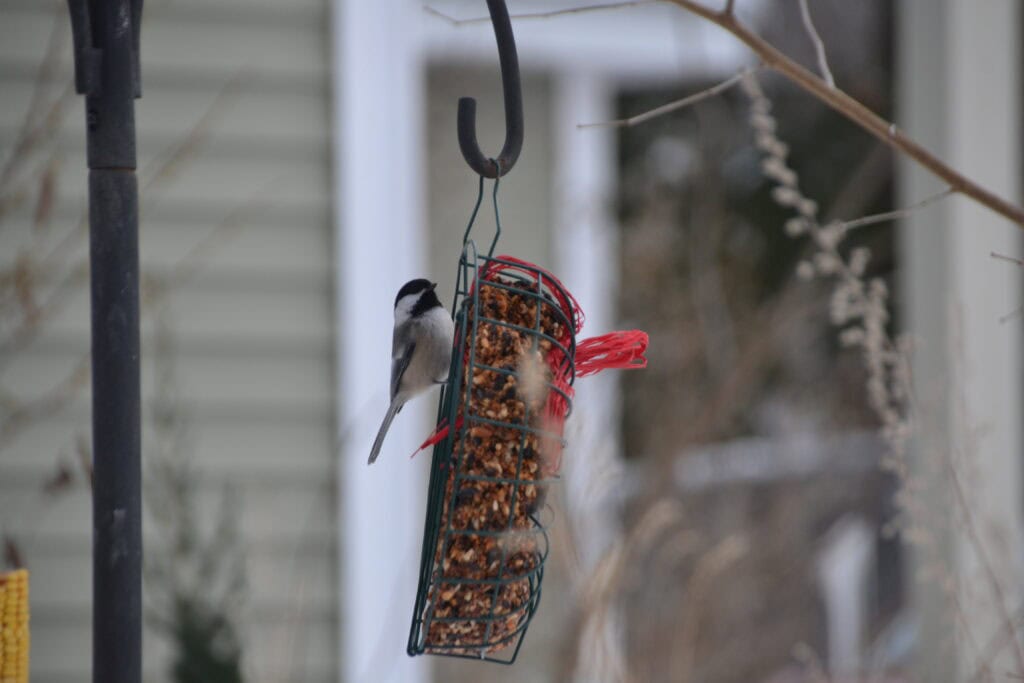Here’s what’s blooming in town this week to make your walks more enjoyable
By Laura Eisener
We have had some very wintry looking snow on the ground for most of the last few weeks, though nothing like the winter 10 years ago, as the meteorologists keep reminding us. In the picture above – taken near Route 1 – the oaks and pines look almost like birches in the shopping plaza lights. The trunks are white because strong wind from one of the recent storms blew the snow sideways from the northeast, and the following cold weather ensured it stuck there for days before melting.
The temperature and humidity last Saturday morning was just right for hoarfrost to form on surfaces – light fluffy ice – essentially frozen dew that forms when the air is very cold in sunny weather. It forms magical patterns and pictures; lines and snowflake patterns are common, as are sharp points of very fragile ice sticking out in all directions.
On Wednesday the Lunar New Year brought us into the Year of the Snake. Usually, we think of the Chinese zodiac as being a 12-year cycle, since there are 12 animals, which come around in order, but looking at it in another way there is a 60-year cycle because there are also five elements (wood, fire, earth, metal and water), which each have yin and yang forms. This is the year of the snake and its element is wood, so it is often referred to as the year of the wood snake. We won’t be seeing any actual snakes springing out at us for several more months though, because in our climate they will be in a state similar to hibernation in dens or under rocks, in wood piles or even underground burrows that other animals have dug. Even if they were disturbed, for example, if you went out to the woodpile to get some logs for a fire, they would be very sluggish and unable to slither very fast. While many people are startled by snakes, they do benefit the garden and the gardener in some ways: Some snakes eat rats, and even smaller snake species can help control grasshoppers and other agricultural pests.
Calandiva (Kalanchoe blossfeldiana) are varieties of kalanchoe that are the descendants of a multi-petalled mutation found in cultivated plants in the Netherlands over a century ago. While kalanchoes are native to Madagascar, they have become popular houseplants in cold climates and garden plants in milder parts of the world. Since they bloom in winter, they are often sold as gifts or decorations for winter celebrations, such as the lunar New Year. The unusual red and yellow color combination in the picture above includes red, which is considered a lucky color in many Asian countries, and yellow, which may represent gold and prosperity.
In a few days it will be Groundhog Day all over again, and we will hear the prediction – according to folklore if February 2 is sunny and the groundhog sees his or her shadow, the groundhog will be frightened and go back to hibernation. In Europe, the foretelling animal may be a hedgehog or even a bear, depending on the country.
When it’s this cold outdoors and garden flowers are scarce, architectural features stand out more than in other seasons. A decorative structure like a tuteur, which is designed to support climbing plants, can be enjoyable even if nothing is growing on it. The one pictured above had cardinal climber (Ipomoea quamoclit) and morning glory (Ipomoea purpurea) growing intertwined during the summer. With its metal bird on top, it casts a charming shadow, and we don’t need to worry about its being scared off like the groundhog!
Several species of real birds are visiting the feeders, including the state bird of Maine and Massachusetts, the black-capped chickadee (Poecile atricapilus). Avian flu has become a concern in recent weeks, driving up the price of eggs in supermarkets, and possibly responsible for the deaths of several large birds on the South Shore. So far, however, I have not heard of disease outbreaks closer to home. At the moment the quantity and species of birds in my neighborhood seems similar to other winters.
Editor’s Note: Laura Eisener is a landscape design consultant who helps homeowners with landscape design, plant selection and placement of trees and shrubs, as well as perennials. She is a member of the Saugus Garden Club and offered to write a series of articles about “what’s blooming in town” shortly after the outbreak of the COVID-19 pandemic. She was inspired after seeing so many people taking up walking.




